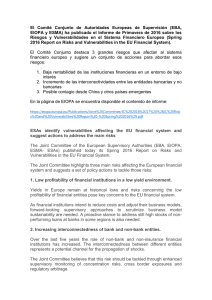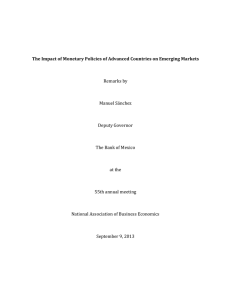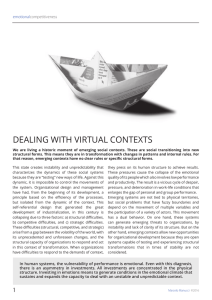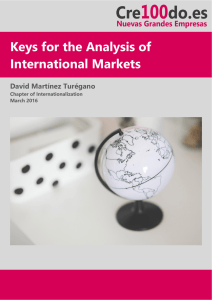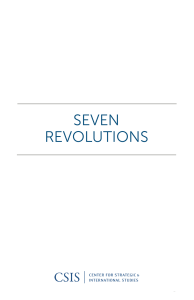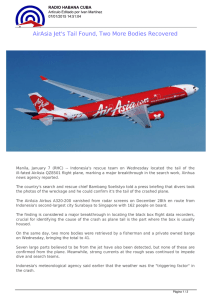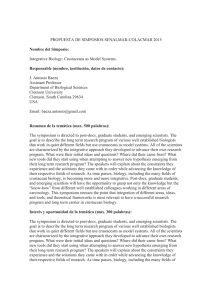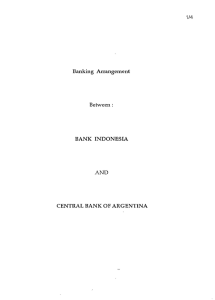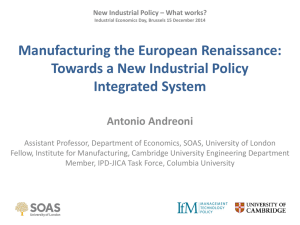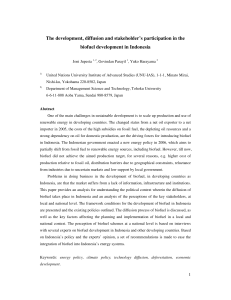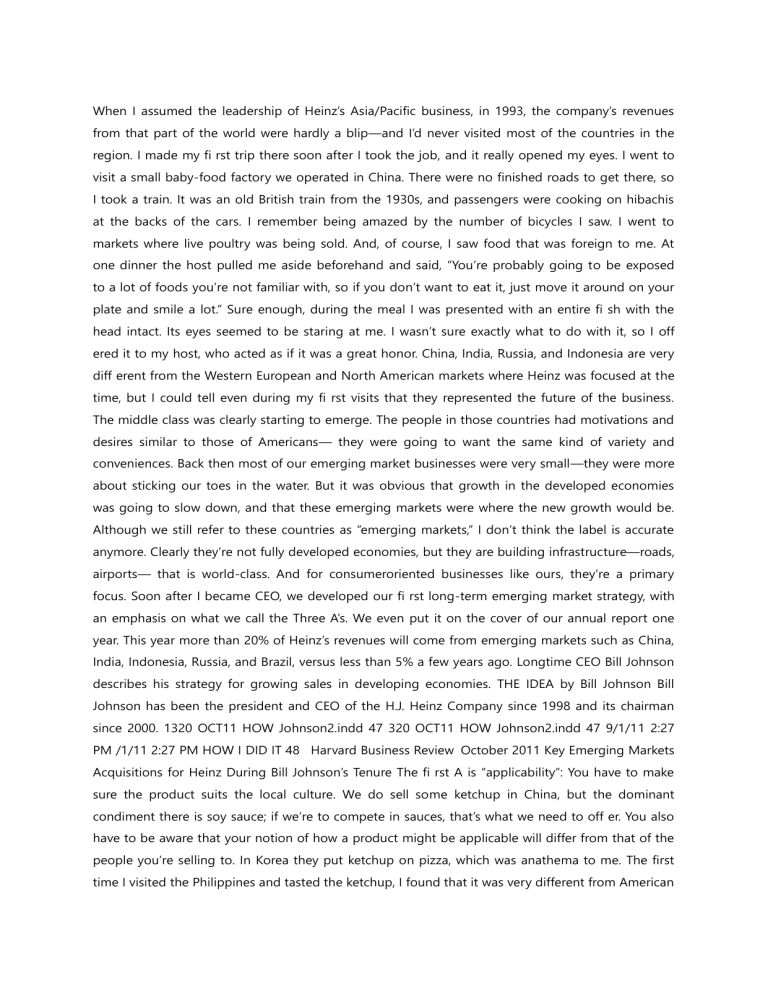
When I assumed the leadership of Heinz’s Asia/Pacific business, in 1993, the company’s revenues from that part of the world were hardly a blip—and I’d never visited most of the countries in the region. I made my fi rst trip there soon after I took the job, and it really opened my eyes. I went to visit a small baby-food factory we operated in China. There were no finished roads to get there, so I took a train. It was an old British train from the 1930s, and passengers were cooking on hibachis at the backs of the cars. I remember being amazed by the number of bicycles I saw. I went to markets where live poultry was being sold. And, of course, I saw food that was foreign to me. At one dinner the host pulled me aside beforehand and said, “You’re probably going to be exposed to a lot of foods you’re not familiar with, so if you don’t want to eat it, just move it around on your plate and smile a lot.” Sure enough, during the meal I was presented with an entire fi sh with the head intact. Its eyes seemed to be staring at me. I wasn’t sure exactly what to do with it, so I off ered it to my host, who acted as if it was a great honor. China, India, Russia, and Indonesia are very diff erent from the Western European and North American markets where Heinz was focused at the time, but I could tell even during my fi rst visits that they represented the future of the business. The middle class was clearly starting to emerge. The people in those countries had motivations and desires similar to those of Americans— they were going to want the same kind of variety and conveniences. Back then most of our emerging market businesses were very small—they were more about sticking our toes in the water. But it was obvious that growth in the developed economies was going to slow down, and that these emerging markets were where the new growth would be. Although we still refer to these countries as “emerging markets,” I don’t think the label is accurate anymore. Clearly they’re not fully developed economies, but they are building infrastructure—roads, airports— that is world-class. And for consumeroriented businesses like ours, they’re a primary focus. Soon after I became CEO, we developed our fi rst long-term emerging market strategy, with an emphasis on what we call the Three A’s. We even put it on the cover of our annual report one year. This year more than 20% of Heinz’s revenues will come from emerging markets such as China, India, Indonesia, Russia, and Brazil, versus less than 5% a few years ago. Longtime CEO Bill Johnson describes his strategy for growing sales in developing economies. THE IDEA by Bill Johnson Bill Johnson has been the president and CEO of the H.J. Heinz Company since 1998 and its chairman since 2000. 1320 OCT11 HOW Johnson2.indd 47 320 OCT11 HOW Johnson2.indd 47 9/1/11 2:27 PM /1/11 2:27 PM HOW I DID IT 48 Harvard Business Review October 2011 Key Emerging Markets Acquisitions for Heinz During Bill Johnson’s Tenure The fi rst A is “applicability”: You have to make sure the product suits the local culture. We do sell some ketchup in China, but the dominant condiment there is soy sauce; if we’re to compete in sauces, that’s what we need to off er. You also have to be aware that your notion of how a product might be applicable will differ from that of the people you’re selling to. In Korea they put ketchup on pizza, which was anathema to me. The first time I visited the Philippines and tasted the ketchup, I found that it was very different from American ketchup. It turned out that it was made from bananas. It didn’t suit me, but it’s what Filipino consumers want, so it’s applicable. The second A is “availability”: You have to make sure you sell in channels that are relevant to the local population. In the United States we’re used to modern grocery stores and supercenters; if a company gets shelf space in Safeway and Kroger and Walmart, its products are available to virtually 100% of the population. But that’s not true in emerging markets. In Indonesia less than one-third of the people buy food in modern grocery stores—they still shop in tiny corner stores or open-air markets. In China chain grocers have a 50% share; in Russia they have around 40%; in India it’s less than 15%. The third A is “affordability”: You have to remember that Westerners are wealthy compared with people in the rest of the world and that the things we take for granted—such as a giant bottle of soy sauce—may be unaffordable luxuries to them. You can’t price yourself out of the market. We try to address this issue by offering different package sizes or recipes. For instance, in Indonesia we sell small packets of soy sauce—the size a Westerner might get with take-out sushi—for three cents apiece. That wouldn’t make sense in a developed market, but in Indonesia we sell billions of those packets because they’re aff ordable, and besides, people don’t necessarily have refrigerators or pantries to hold larger sizes for months at a time. A few years after we unveiled the Three A’s strategy, I added a fourth—“affinity.” That means you want local employees and local customers to feel close to your brand, and you need to understand how they live. That’s a large part of why we rely on local managers for our emerging markets businesses. I believe they bring a deep understanding of local consumers and employees. Typically we have only one or two expat managers in any market. When we need to improve skills such as marketing or fi nance, or to implement our particular ways of doing business, we send in our Emerging Markets Capability Team— a group of senior people from Western businesses who travel around and coach local managers. In some cases we take the Heinz brand into a market and try to establish it organically. We did that in China with baby food— we started there in the mid-1980s, and tob l Jo bottl l l hnson’s Tenure b ttl hns MEXICO COSTA RICA BRAZIL 2006 Acquired ABAL in Mexico (undisclosed amount) 1999 Acquired ABC Indonesia for $78 million 2004 Acquired 50.1% of Heinz Foods South Africa, a joint venture with Pioneer Foods (undisclosed amount) 2001 Acquired Productos Columbia, maker of Banquete sauces, in Costa Rica (undisclosed amount) We try to address aff ordability by off ering diff erent sizes. In Indonesia we sell small packets of soy sauce for three cents apiece. 2005 Acquired Petrosoyuz in Russia for $75 million PHOTOGRAPHY: TOP COURTESY OF HEINZ; JOHNSON, GETTY IMAGES 1320 OCT11 HOW Johnson2.indd 48 320 OCT11 HOW Johnson2.indd 48 9/1/11 2:27 PM /1/11 2:27 PM From Desktops to Devices SECURELY NAVIGATING THROUGH THE CLOUD The tension between information security and business productivity has never been so acute, as organizations need to ensure that workers have access to more resources in more places, on more devices than ever before. So how can organizations manage risk more effectively while deploying personnel and resources wherever and whenever they’re needed? Learn how virtualization offers a roadmap for firms looking to securely integrate innovative new devices into established networks and more costeffectively exploit the economics of evolving clouds — public, private, and hybrid. FREE VIDEO WEBINAR Featuring Michael Schrage, research fellow with the Sloan School of Management’s Center for Digital Business. He is a senior advisor to MIT’s Security Studies Program and consults to the U.S. government on national security systems innovation. Thursday, September 29, 2011 Noon EDT REGISTER NOW AT www.krm.com/hbr/CloudNavBN sponsored by day Heinz is China’s leading brand of baby food. But more often we “buy and build.” For instance, over the past year Heinz acquired Quero in Brazil and Foodstar in China to accelerate our growth. Under our strategy, we look for solid brands with good local management that will get us into the right channels, and we buy local infrastructure as well. Then we can start selling other brands—including Heinz—through the same channels. Our approach to evaluating acquisitions in emerging markets is very diff erent from our approach in developed economies. Some of the due diligence is the same: We look at the operating metrics of the business. Is it growing? Are there synergies? Can we manage it? Does it fi t with our core business? Does it add scale or scope? This business-focused due diligence is often complicated by the premiums we pay for an emerging market acquisition—you want to be really sure the growth is going to be there, so you have to look at per capita consumption trends, the macro environment, and the overall state of the category. Then there’s a whole second set of due diligence issues, which also differ from what we do in developed economies. We look at how the company goes to market, the tax system, the regulatory environment, currency trends, and the political climate, comparing them with what exists in the United States. We take these things for granted in developed economies, but they’re a big consideration in emerging CHINA markets, where governments are often much more active. This process may take a lot of time, and the companies we’re considering as acquisitions are sometimes frustrated by that. But these issues are very important. We’ve walked away from deals in Ukraine, Vietnam, and other markets because our due diligence told us there were considerable risks involved in trying to generate acceptable returns on the businesses. For managers, probably the most important factor in growing a business in an emerging market is understanding the risks. We’ve tried to manage that by diversifying: Over the years, we’ve invested pretty equally in all the BRIC countries plus Indonesia and Venezuela. We’ve begun investing in South Africa and Mexico. Diversifying helps mitigate not only the political risks but also the currency risks, which require really adept financial management. I sometimes say that Heinz used to be a dollar-pound-euro company, but there’s no doubt that in the future it will be dominated by the fi ve R’s: the Brazilian real, the Chinese renminbi, the Indian rupee, the Indonesian rupiah, and the Russian ruble. Those currencies are volatile, but they’re going to be the strongest currencies in the world going forward, because their economies are the strongest. If you spread your risks across markets and across currencies, you won’t panic or run away the fi rst time you have a blowup. However, you also have to know when the risk outweighs the potential reward. RUSSIA CHINA INDONESIA SOUTH AFRICA EGYPT 2010 Acquired remaining 49% interest in Cairo Food Industries in Egypt for $62 million 2010 Acquired Foodstar in China for $165 million 2011 Acquired Coniexpress, maker of Quero sauces, in Brazil for $494 million 1320 OCT11 HOW Johnson2 Layout [S].indd 49 320 OCT11 HOW Johnson2 Layout [S].indd 49 8/30/11 9:35 AM /30/11 9:35 AM HOW I DID IT 50 Harvard Business Review October 2011 HBR.ORG For example, we created a really good business in Zimbabwe during the 1990s. But by the early 2000s the government was too unstable, the currency had devalued, and we couldn’t plan or get resources. So we walked away from the market. We also pulled out of some cities in Russia after the ruble devalued in the 1990s. But generally we focus on the long term. We have learned that to succeed in emerging markets, you need to be risk aware but not risk averse. Indonesia provides a great example of that. We bought a big business there in 1999. The country was just starting to democratize and have elections; it wasn’t especially stable. Frankly, some people wondered if it was a good place for an American company. Today that’s a $400 million business for us, versus $80 million when we bought it. ABC is one of the world’s largest soy sauce brands, and it’s very profi table. Another key to growing in emerging markets is to tailor products to local tastes. I try to sample many of the products we bring to market. I’m curious, and local managers and employees really appreciate it when I try something unfamiliar. Some of the foods don’t agree with me—like the Philippines banana ketchup. We sell a chili sauce in Indonesia. Every time I go, they ask me to taste it. It’s so hot that I have to drink a gallon of water afterward, but the local population loves it. Sardines are popular in Indonesia, and meat pies are popular in South Africa—I’m not a big fan of either. In India we acquired Complan, a high-protein nutritional beverage for children. We recently introduced a new variety that tastes like almonds. Personally, I’m not crazy about the taste; fortunately, Indian consumers have a different opinion. This year we expect Complan to generate more than $200 million in sales, and it’s our best-selling product in India. You have to be mindful of the “rule of the golden tongue”—just because you don’t like something doesn’t mean the local population won’t like it. Also, I’m always looking to see if some of these products can be sold in developed economies. Every year, I ask our managers in those markets to look at emerging market innovations that might work there. Consumers all over the world are looking for bargains, so a lot of ideas for lowerpriced products are becoming relevant in Western markets. I don’t like the phrase “mature brands,” and we still manage to grow sales of products like ketchup, even in soft Western economies. But it takes hard work and innovation. We’ve had a lot of success with new packaging—such as squeeze bottles—and now we’re manufacturing more-sustainable bottles that use up to 30% renewable plant-based material and innovative technology developed by our partner, the Coca-Cola Company. Innovation can still drive growth in developed markets—just look at Apple. But it’s defi nitely more diffi cult. In emerging markets Heinz is also increasingly focused on connecting with consumers through social media to glean valuable insights and drive awareness of our new products and innovations in markets like Indonesia and India. We expect more than 20% of our revenues (over $2 billion) to come from emerging markets this year—and more than 30% by 2015. Our U.S. business is around 33%, so that’s really significant. Our company is ahead of U.S. competitors in this area— they’re rushing to catch up. Many of them have made mistakes in emerging markets. They’ve become too dependent on one or two markets, instead of diversifying. They’ve relied on expats to manage their local businesses. They’ve rushed in with Western brands, Western package sizes, Western pricing, without understanding the nuances of the markets. Many of them have also been too impatient. They’re ready to walk away too quickly. Those markets require patience. Our Indian business took seven or eight years to get right. You have to be patient, fl exible, and open to ideas from local management. At the same time, Heinz is leveraging the strength of our global brand. For instance, we are growing our ketchup and condiment sales globally by partnering with quick-serve restaurant chains that are expanding rapidly in emerging markets. Being successful in those markets also requires that every manager—including the CEO—work hard to build relationships. I have attended a lot of banquets in Asia. They’re an important way to make friends, especially with government officials, but they can be exhausting. When I travel there today, I’m usually happy to have a dinner at the hotel. Still, the cultural diff erences can be amusing. A few years ago the Chinese government presented me with the Marco Polo Award, which they give to the company that does the most to improve U.S.– China relations. They had a big dinner with a lot of government officials and a lot of ceremony. When I entered the room, they played “Hail to the Chief.” My wife couldn’t stop laughing. Despite the cultural diff erences, we’ve found that customers everywhere are similar in some ways: They all want convenient, high-quality products at good prices. Heinz is a 142-year-old company that’s had only five chairmen, and in many of those cultures that kind of longevity is appreciated. Ultimately, it’s all about courage. Are you prepared to stick it out? Emerging markets are the future—but they’re not for the faint of heart.
